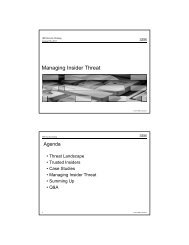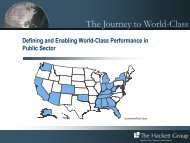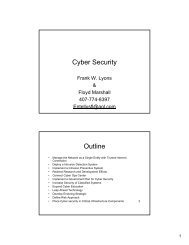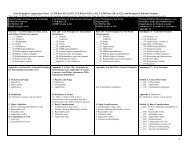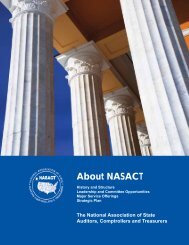Advisory Committee on Tax Exempt and Government Entities (ACT ...
Advisory Committee on Tax Exempt and Government Entities (ACT ...
Advisory Committee on Tax Exempt and Government Entities (ACT ...
You also want an ePaper? Increase the reach of your titles
YUMPU automatically turns print PDFs into web optimized ePapers that Google loves.
<strong>Tax</strong> Treatment Of Cellular Teleph<strong>on</strong>es And Internet-Provider AllowancesThere are no streamlined substantiati<strong>on</strong> rules for cell ph<strong>on</strong>es as there are for vehicles.No pers<strong>on</strong>al use or de minimis pers<strong>on</strong>al use policies are authorized under the secti<strong>on</strong>274(d) substantiati<strong>on</strong> rules.The substantiati<strong>on</strong> rules do not permit employers to adopt “no pers<strong>on</strong>al use” or “deminimis pers<strong>on</strong>al use policies” with respect to cellular ph<strong>on</strong>es, such as the rulespermitting reliance <strong>on</strong> written policies for “vehicles not used for pers<strong>on</strong>al purposes” <strong>and</strong>“vehicles not used of pers<strong>on</strong>al purposes other than commuting,” which streamline or atleast minimize the recordkeeping requirements. Treas. Reg. 1.274-6T(a)(2) <strong>and</strong> 1.2746T(a)(3).Note: If the employer implements such a policy with respect to its cellular ph<strong>on</strong>eprogram, reliance <strong>on</strong> same will not qualify as sufficient evidence corroboratingthe employee’s own statement <strong>and</strong>, therefore, will not satisfy the substantiati<strong>on</strong>requirements of secti<strong>on</strong> 274(d) for purposes of excluding the business use as aworking c<strong>on</strong>diti<strong>on</strong> fringe benefit or a tax-free business expense reimbursement.In such a case, the result is that the entire value of the benefits (that weretreated as tax-free) become taxable <strong>and</strong> subject to the retroactive impositi<strong>on</strong> ofpayroll taxes if the IRS successfully challenges the program in an employmenttax examinati<strong>on</strong>.Although the regulati<strong>on</strong>s permit taxpayers to substantiate the business use of a cellularph<strong>on</strong>e by maintaining adequate records for a porti<strong>on</strong> of the year, an employer relying <strong>on</strong>such a ‘sampling’ method would still be advised to collect the records pertaining to thesampling period <strong>and</strong> also be prepared to dem<strong>on</strong>strate that the records arerepresentative of the use for the calendar year. See, e.g., the rules for ‘substantiati<strong>on</strong>by other sufficient evidence’ in Treas Reg. 1.274-5T(c)(3), which permits the use ofsampling for listed property if the taxpayer can dem<strong>on</strong>strate by other evidence that theperiods for which <strong>and</strong> adequate record is maintained are representative of the use forthe year.There has been some recent IRS examinati<strong>on</strong> activity in this area. Over the years, the<strong>Tax</strong> Court has sustained the requirements of detailed substantiati<strong>on</strong> under secti<strong>on</strong>274(d) with respect to cellular ph<strong>on</strong>es. See, e.g., Vaksman v. Commissi<strong>on</strong>er, T.C.Memo. 2001-165, aff’d 90 AFTR2d 2002-7639 (5 th Cir. 2002); Woods v. Commissi<strong>on</strong>er,T.C. Memo. 2004-114; Megibow v. Commissi<strong>on</strong>er, T.C. Memo. 2004-41; Nitschke v.Commissi<strong>on</strong>er, T.C.Memo. 2000-230; <strong>and</strong> Ramsey v. Commissi<strong>on</strong>er, T.C. Memo. 1996189. Therefore, if the IRS were to review an employer’s cellular ph<strong>on</strong>e program <strong>and</strong>determine that the substantiati<strong>on</strong> requirements had not been met, judicial precedentexists in favor of the government.There are references to cell ph<strong>on</strong>es in The IRS Audit Techniques Guide <strong>on</strong> FringeBenefits. In a secti<strong>on</strong> entitled, “Employee Use of Listed Property,” IRS examiners areadvised by the Guide that cellular ph<strong>on</strong>es are listed property <strong>and</strong> subject to detailedADVISORY COMMITTEE ON TAX EXEMPT AND GOVERNMENT ENTITIES (<strong>ACT</strong>) June 11, 2008 Page 5






